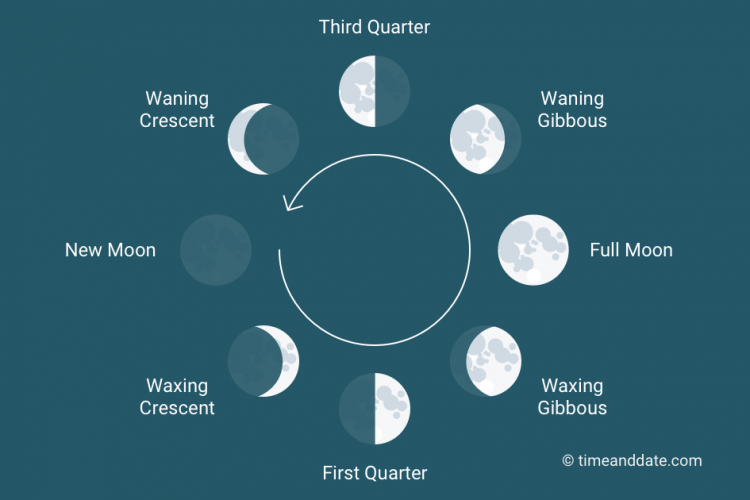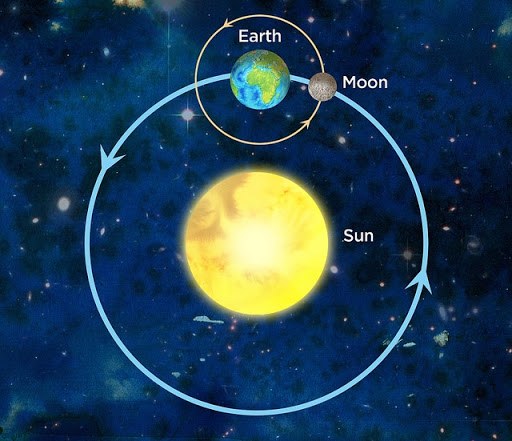Since the Sun is behind the Moon from Earths perspective the. The moon exerts no gravitational force on the earth.

Earth Moon And Seasons General Science Quiz Quizizz
Centrifugal force acting on the moon balances the force of the earths gravity.

. The Moons movements cause the phases of. We would observe a totally dark moon starting to become illuminated when the moon moves between which. The Moons orbital path is sometimes above and sometimes below the plane of Earth.
The Moon provides a natural laboratory. The moon is in free fall. The amount of light produced by.
There is no gravity acting on the moon because it is in orbit. A 24 hours B 12 hours C 30 days D 365 days 2 Which of the following best describes the Earths movement around the sun. The Moon revolves around the Earth and rotates on its axis the at the same angular velocity.
The study of the Moons motions has been central to the growth of knowledge not only about the Moon itself but also about fundamentals of celestial mechanics and physics. The Moon only revolves around Earth and does not rotate. Earth revolves in a circular motion around the Moon.
The phases of the Moon are caused by the. With minor modifications they also describe the Moons motion about the Earth the orbits of Jupiters satellites and even the orbital motions of binary stars. A diagram of the earth-sun-moon system is provided.
Which word best describes the changes in the Moons appearance during the sequence above. The Moonscycle of phases can be observed from Earth because the Moon. This is also the first phase of the moon.
Which statement best describes the orbit of Earth. The motion of the Moon is that it revolves around the Earth in an elliptical orbit every 273 days. B First it would stop revolving around the Earth because gravity is providing the centripetal force.
The revolution of the Moonaround the Earth. The diagram shows the relative position of the moon at various times in the lunar cycle. The Average Motion of the Moon The Moon moves around the Earth in an approximately circular orbit going once around us in approximately 273 days or one sidereal period of revolution.
The points where it crosses the ecliptic are called the ascending and descending nodes depending on whether it is moving north or south respectively. B The Earth moves in a circular pattern around the Moon. Earth casts a shadow on the Moon as it moves through the lunar cycle.
The tilt of the Moons orbit contributes to this but its mostly due to the tilt of our Earth. Moons revolution around the Earth. Earth revolves around the planets within the Milky Way galaxy.
Tilt of the axis of Earth and orbit of Earth around the sun. The new Moon occurs when the Moon Earth and Sun all lie along approximately the same line. If you look left the ramp slopes up.
The Earth tilts back and forth as it revolves around the Moon. Since one side of the Moon has greater density than the other the force of the Earths gravity causes that side to always face the Earth as it moves in its orbit. Without that you cannot have uniform circular motion.
The Sun lights up different sides of the Moon as it orbits around Earth its the fraction of the Moon from which we see reflected sunlight that determines the lunar phase. As the stars appear to move westward because of Earths daily rotation and its annual motion about the Sun so the Moon slowly moves eastward rising later each day and passing through its phases. The length of a day on the Moon is 2953 Earth days.
If you look right the ramp slopes. Finally the Moon appears to tilt back and forth like a metronome. The most useful laws of nature can be applied in many different situations.
Up to 24 cash back 1 It takes _____ for the earth to revolve around the sun. The Moon revolves around the Earth and rotates on its axis the at the same angular velocity. You cant see the moon because it is between the Earth and the Sun Moon phase that occurs when the Moon is between Earth and the Sun at which point the Moon cannot be seen because its lighted half is facing the Sun and its dark side faces Earth.
The Moons orbit is inclined at an angle of 5 to the Earths so it is usually either above or below the plane of the ecliptic. The Moon revolves or moves around the Earth in a path called its orbit and rotates or spins in space. Earth has a tilt of 235 degrees on its axis which means that when we observe the Moon from Earth its a little like were standing sideways on a ramp.
2 on a question. The movement of the earth water is that the moon move around the earth also the gravitational pull of the moon moves the water. As it does this its position changes relative to the stars.
A The Earth is closer to the sun in Summer than in Winter. The best evidence that the distance between the Moon and the Earth varies is provide by the apparent change in the Moons. C The Earths axis moves back and forth.
Second the Moon would continue rotating because gravity affects an objects center of mass. Earth revolves around the Sun and the Moon revolves around Earth. The Moon would simply fly off in whichever direction it was moving at the moment gravity ceased.
Keplers three laws invented to describe the orbital motion of planets about the Sun are very useful. Earth rotates on its own axis and revolves around the Sun. When the moon Earth and sun are in a line-The gravitation force of the sun and the moon are combined-Occurs when there is a full and new moon-the high tide is higher than a normal high tide-low tide is lower than normal.

Phases And Motions Of The Moon Astronomy


0 Comments